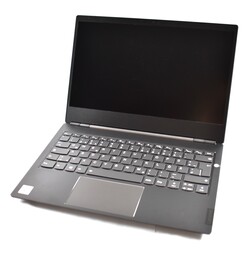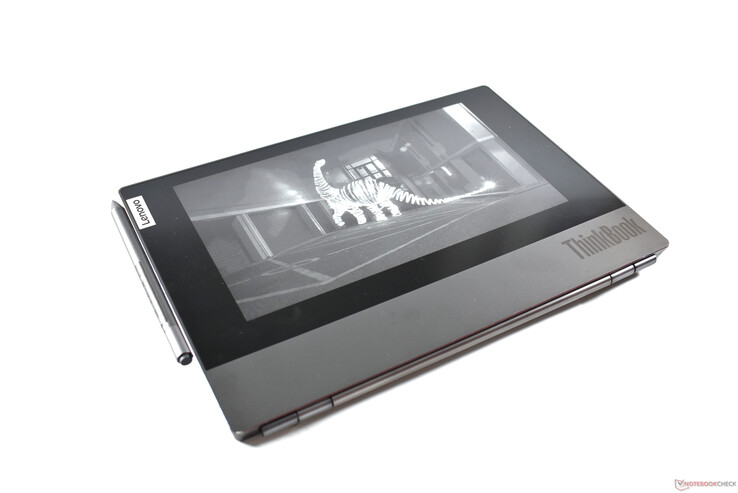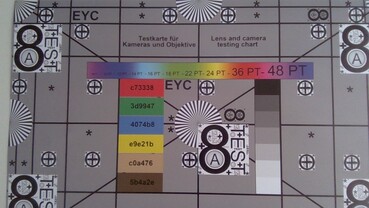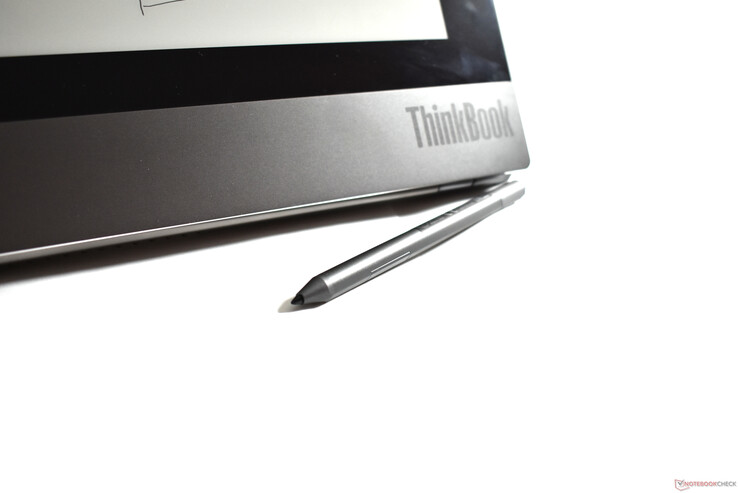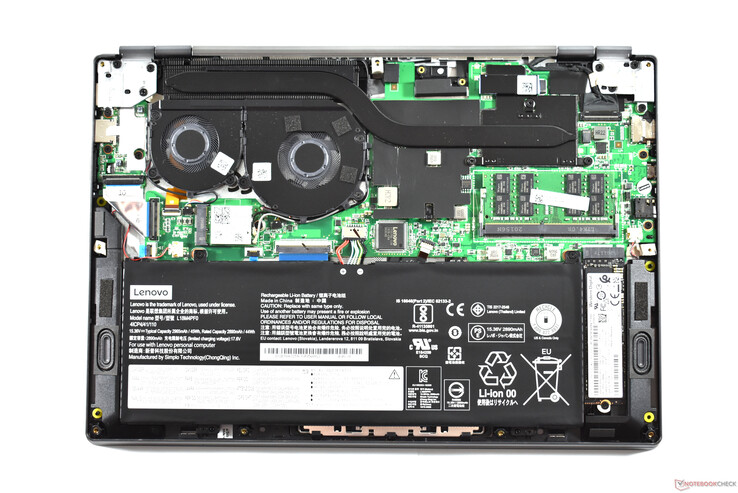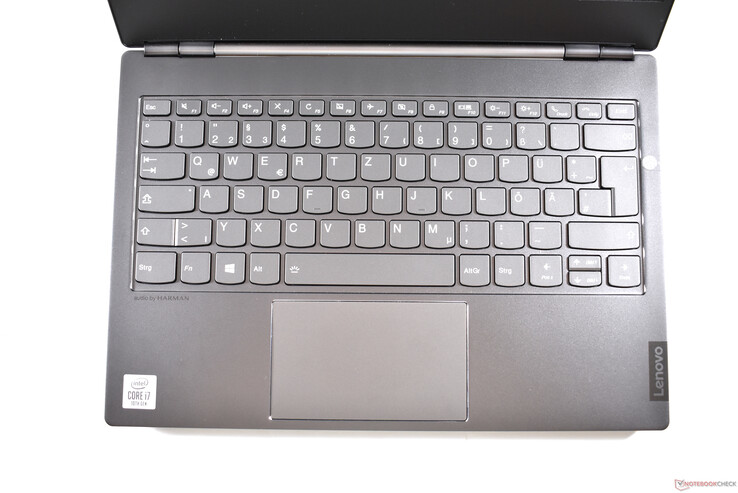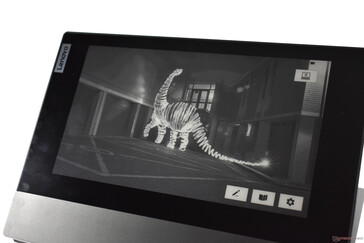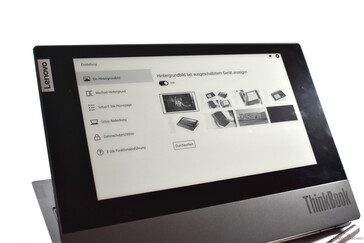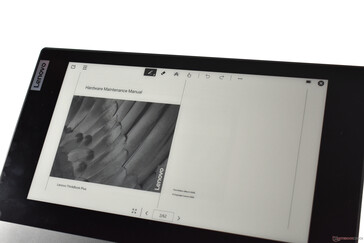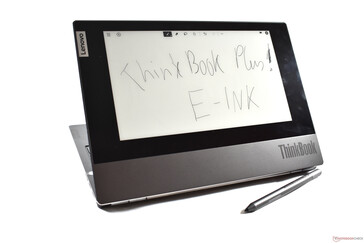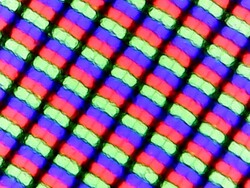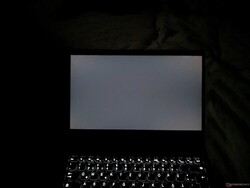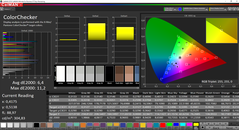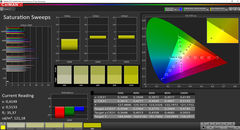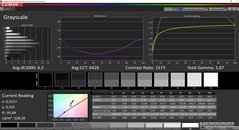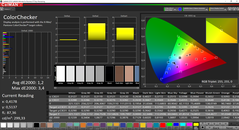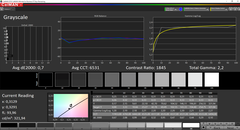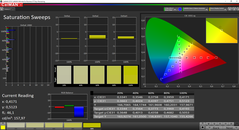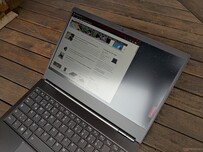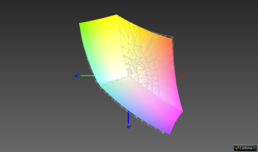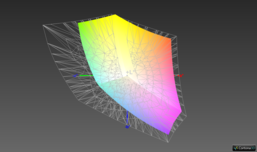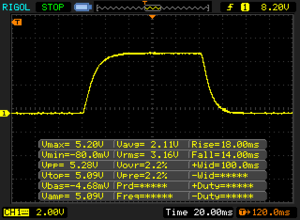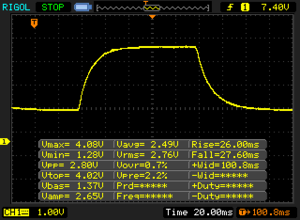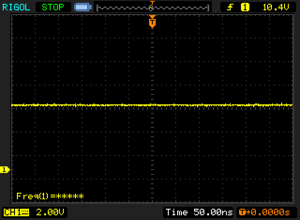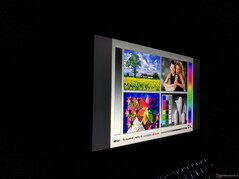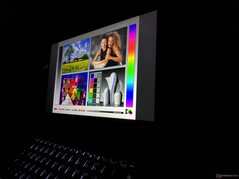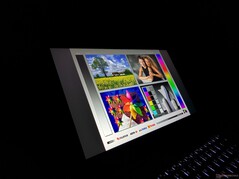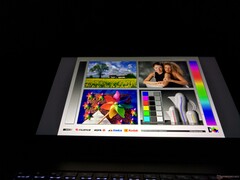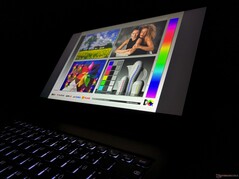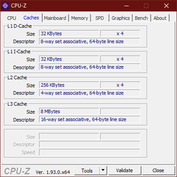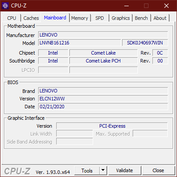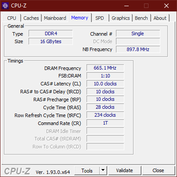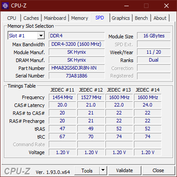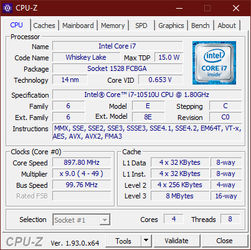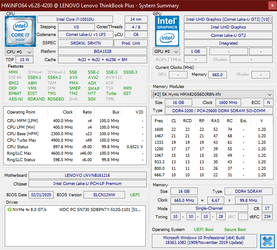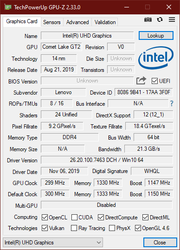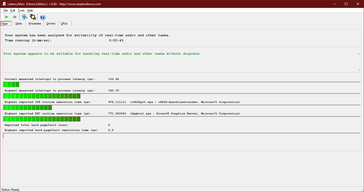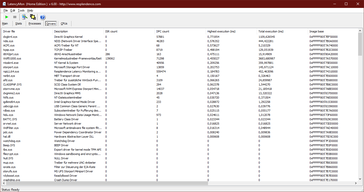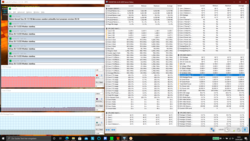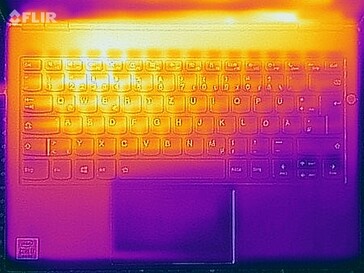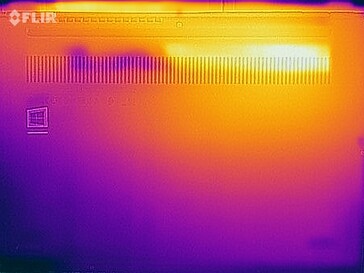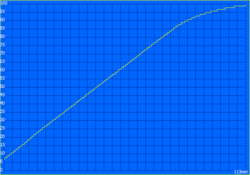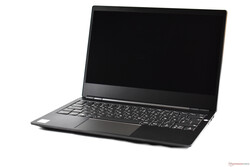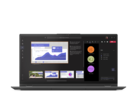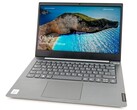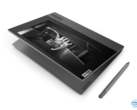Lenovo ThinkBook Plus Laptop Review: Unique E-Ink Display Meets Average Hardware
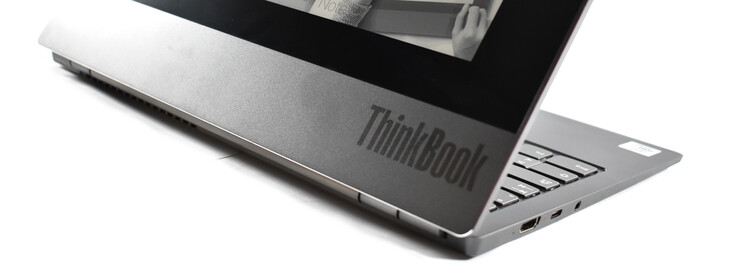
E-ink, sometimes referred to as e-paper, is a technology that is rarely ever seen in traditional computers despite the fact that it offers a number of advantages. For example, it emulates and looks strikingly similar to real paper, much more so than traditional LCD or OLED displays, and its power consumption is significantly lower to boot.
Lenovo is the latest in a short list of manufacturers that decided to give the e-ink technology a shot and equipped its latest ThinkBook series for SMBs (small and medium-sized businesses) with an additional e-ink display. The ThinkBook Plus therefore comes with two displays, a traditional 13.3-inch display with FHD LCD IPS panel on the inside and another 10.8-inch monochrome e-ink display on the outside of the display lid. Our review unit’s remaining specifications are fairly common: Core i7, 16 GB of RAM, and 512 GB of SSD storage. At the time of writing our review unit cost $1,529 with a more affordable i5/8GB/256GB SKU available for $1,299.
As such the ThinkBook is clearly competing in a price range where we usually tend to find traditional business notebooks. Our comparison group is therefore comprised of the Dynabook Portege X30L-G, Fujitsu LifeBook U939, and Lenovo ThinkPad X13.
Rating | Date | Model | Weight | Height | Size | Resolution | Price |
|---|---|---|---|---|---|---|---|
| 86.9 % v7 (old) | 10 / 2020 | Lenovo ThinkBook Plus 13 i7 i7-10510U, UHD Graphics 620 | 1.4 kg | 17.4 mm | 13.30" | 1920x1080 | |
| 85.1 % v7 (old) | 05 / 2020 | Dynabook Portege X30L-G1331 i5-10210U, UHD Graphics 620 | 859 g | 17.9 mm | 13.30" | 1920x1080 | |
| 83.7 % v7 (old) | 07 / 2020 | Fujitsu Lifebook U939 i5 i5-8265U, UHD Graphics 620 | 900 g | 15 mm | 13.30" | 1920x1080 | |
| 89.5 % v7 (old) | 08 / 2020 | Lenovo ThinkPad X13-20UGS00800 R7 PRO 4750U, Vega 7 | 1.3 kg | 16.9 mm | 13.30" | 1920x1080 |
ThinkBook Plus with Metal Case
With the display lid opened the ThinkBook Plus looks strikingly similar to the ThinkBook 13s. Neither color nor form and design are any different, and the only update is the relocated fingerprint reader that can now be found along the right-hand edge. The overall design language is modern and minimalist. Given that it lacks any sort of color accentuations, such as for example the ThinkPad’s legendary red TrackPoint, it looks even more inconspicuous with is dark-gray case. Only the chrome elements around the touchpad and the display lid introduce at least some form of visual flair.
However, things quickly change when looking at the exterior of the display lid where we find the device’s unique and special feature, the second display. As a result, it is partly made of glass with a metal bottom chin, which results in a not particularly sturdy and solid design. While depressing the rear did not result in any ripples on the main display, we were able to twist and warp the entire display lid very easily, more so than on other laptops with metal case. In return, the base unit turned out to be almost immune to external forces and we were unable to depress its aluminum top cover at all.
The neatly looking pipe-like hinges are very strong and managed to hold the display firmly in place with an opening angle of 180 degrees. Unfortunately, one-handed operation is not possible and given that the display is very top-heavy you need to be careful when the ThinkBook Plus is standing close to an edge lest it tips over backwards.
Overall, its weight of 1.4 kg is fairly high for a 13.3-inch laptop, especially when compared to incredibly lightweight competitors such as the U939. The ThinkBook Plus may be slightly thinner than the Lifebook but thicker than most other compact office laptops. When compared to the ThinkBook 13s the main reason for its added heft and bulk would most certainly be the additional e-ink display.
Connectivity of Lenovo’s Laptop Could be Better
Minimalism was not only key when designing the device but also when determining its connectivity. No card reader and but a single USB-C port that is used for charging and carries a DisplayPort signal but lacks Thunderbolt support. Legacy ports include a single HDMI as well as two USB-A ports with a more than questionable positioning (HDMI sits behind the charging port) and spacing (the USB ports are very close to each other). Ideally, the charging port should be located as far back as possible.
Communication
Despite its modern and up-to-date Intel Wireless AX201 Wi-Fi card the ThinkBook Plus’s Wi-Fi transfer rates were comparatively low. We would have expected more from a 2x2 design.
Webcam
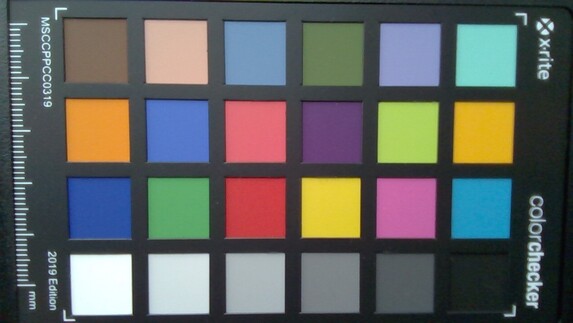
Security
Its SMB trait means that the ThinkBook does not come with the same plethora of security features as full-fledged business laptops such as for example the Lenovo ThinkPad X13. Among others it lacks a smart card reader, a Kensington lock, an infrared camera, and a mechanical webcam shutter. The only security feature available is the fingerprint reader integrated into the power button. It worked flawlessly in our tests, but we found its position on the side to be less than ideal.
Accessories
The included power supply is the same compact 65 W unit found on the ThinkPad X1 Carbon Gen 8. In addition, Lenovo also includes a digitizer pen, Lenovo accessory article number 4X80Z50965. It feels good when held in hand, offers multiple buttons, and attaches to the side of the case due to the fact that it is magnetic and made of metal.
Maintenance
A total of nine Torx screws secure the bottom panel to the base unit. Keep in mind that these screws will fall out very easily and are thus prone to get lost. Once all screws have been removed the bottom panel is held in place by a number of plastic clips that have to be undone, ideally starting around the hinges.
Once removed you have access to various internal ThinkBook Plus components, such as the battery, the fans, or the thermal compound. Neither RAM or Wi-Fi module nor SSD are soldered and can thus all be replaced and upgraded. Unfortunately, the device is equipped with just a single RAM slot.
Warranty
Lenovo’s default warranty is limited to 12-months of bring-in services, which is short for a laptop in this price range above 1,000 Euros. Many consumer laptops in this price range come with two years of warranty, and many business laptops even with three years of on-site service. Keep in mind that warranty terms differ from one country to another, and European customers tend to get much longer warranties than for example US customers where 12 months of limited warranty are the norm rather than the exception.
Input Devices: E-Ink as ThinkBook Plus Bonus
Keyboard
The keyboard is identical to that of the ThinkBook 13s. Layout and design are derived from Lenovo’s IdeaPad and Yoga consumer-line of laptops, and the backlit keyboard has nothing in common with Lenovo’s ThinkPad keyboards. This, however, does not render the keyboard unusable per se. Its smooth dark-gray keys offer adequate key travel and a comparatively well-defined and firm accentuation point. This keyboard will not go down as one of the best of its kind, but it remains a usable input device, nevertheless.
Touchpad
At 10.5 x 8.3 cm (4.1 x 3.3 inches) the touchpad is comparatively large but far from ginormous. Its matte surface is comparatively smooth but at the same time unable to keep up with higher-quality glass-covered units. The same applies to its integrated buttons’ click mechanism, which could have been less noisy and slightly softer. Software support, on the other hand, was superb and trouble-free, and supports gesture detection and input thanks to Microsoft’s Precision drivers.
The lack of a TrackPoint pointing device is a deliberate decision on Lenovo’s part in order to create a distinction between ThinkBooks and ThinkPads.
E-Ink Display
The ThinkBook Plus may not have a touchscreen per se but supports touch input nevertheless as its matte monochrome FHD e-ink display at the rear side of the display lid includes a capacitive touch layer. It does not support multi-touch (one finger only) but the included Lenovo digitizer instead.
By default, it comes with two applications: a reader application for opening and reading PDF documents and a notes application for taking notes and drawing. This may render the ThinkBook Plus very interesting for educational purposes and may even replace a dedicated e-ink equipped eBook reader.
The LCD Display is Matte
The ThinkBook Plus’s main display runs at a native resolution of 1920 x 1080 (FHD) and does not support touch input. All available panels are matte, based on IPS technology, and lack support for touch input. At just 300 nits its maximum brightness is mediocre at best, however Lenovo claims full Dolby Vison HDR support.
On a brighter note we found that the panel exceeded its specified maximum brightness significantly and peaked at 329 nits. That said it is still unable to keep up with its similarly priced business notebook competitors, some of which offer much brighter displays. The difference between the ThinkBook Plus and the Dynabook Portege is particularly striking. Our Lenovo ThinkPad X13 review unit’s display was slightly dimmer than the ThinkBook’s but it can be optionally equipped and purchased with much brighter displays. In the ThinkBook’s case the lack of LCD options is a clear disadvantage.
| |||||||||||||||||||||||||
Brightness Distribution: 89 %
Center on Battery: 328 cd/m²
Contrast: 1562:1 (Black: 0.21 cd/m²)
ΔE ColorChecker Calman: 6.4 | ∀{0.5-29.43 Ø4.78}
calibrated: 1.2
ΔE Greyscale Calman: 6.5 | ∀{0.09-98 Ø5}
95.9% sRGB (Argyll 1.6.3 3D)
61.6% AdobeRGB 1998 (Argyll 1.6.3 3D)
67% AdobeRGB 1998 (Argyll 3D)
96.1% sRGB (Argyll 3D)
66% Display P3 (Argyll 3D)
Gamma: 2.87
CCT: 6428 K
| Lenovo ThinkBook Plus 13 i7 LP133WF7-SPB1, IPS LED, 1920x1080, 13.3" | Dynabook Portege X30L-G1331 Toshiba TOS508F, IPS, 1920x1080, 13.3" | Fujitsu Lifebook U939 i5 Sharp SHP14BD, IPS, 1920x1080, 13.3" | Lenovo ThinkPad X13-20UGS00800 B133HAK01.1, IPS LED, 1920x1080, 13.3" | |
|---|---|---|---|---|
| Display | 1% | -1% | -2% | |
| Display P3 Coverage (%) | 66 | 66.9 1% | 65.3 -1% | 64.8 -2% |
| sRGB Coverage (%) | 96.1 | 97.6 2% | 95 -1% | 95.6 -1% |
| AdobeRGB 1998 Coverage (%) | 67 | 67.8 1% | 66 -1% | 65.7 -2% |
| Response Times | -7% | 2% | 0% | |
| Response Time Grey 50% / Grey 80% * (ms) | 53.6 ? | 54.8 ? -2% | 55.2 ? -3% | 56.8 ? -6% |
| Response Time Black / White * (ms) | 32 ? | 35.6 ? -11% | 29.6 ? 7% | 30 ? 6% |
| PWM Frequency (Hz) | 23810 ? | 211.9 ? | ||
| Screen | 17% | -2% | 1% | |
| Brightness middle (cd/m²) | 328 | 482 47% | 384 17% | 331 1% |
| Brightness (cd/m²) | 329 | 452 37% | 362 10% | 315 -4% |
| Brightness Distribution (%) | 89 | 91 2% | 90 1% | 90 1% |
| Black Level * (cd/m²) | 0.21 | 0.4 -90% | 0.31 -48% | 0.21 -0% |
| Contrast (:1) | 1562 | 1205 -23% | 1239 -21% | 1576 1% |
| Colorchecker dE 2000 * | 6.4 | 1.85 71% | 4.8 25% | 6.1 5% |
| Colorchecker dE 2000 max. * | 11.2 | 3.08 72% | 9.4 16% | 10 11% |
| Colorchecker dE 2000 calibrated * | 1.2 | 1.2 -0% | 1.4 -17% | 1.2 -0% |
| Greyscale dE 2000 * | 6.5 | 2 69% | 6.6 -2% | 6.3 3% |
| Gamma | 2.87 77% | 2.1 105% | 2.2 100% | 2.77 79% |
| CCT | 6428 101% | 6822 95% | 7999 81% | 6938 94% |
| Color Space (Percent of AdobeRGB 1998) (%) | 61.6 | 62.5 1% | 61.2 -1% | 60.7 -1% |
| Color Space (Percent of sRGB) (%) | 95.9 | 97.7 2% | 95 -1% | 95.4 -1% |
| Total Average (Program / Settings) | 4% /
11% | -0% /
-1% | -0% /
1% |
* ... smaller is better
We found no noticeable color tint on the ThinkBook’s display. Colors were rendered significantly too dark, though. Using CalMAN and the X-Rite i1Pro2 we were able to properly calibrate the display and improve color accuracy noticeably. Once calibrated the display performed very well thanks to its low black level of 0.21 nits and its high contrast ratio of 1562:1.
Unfortunately, it barely failed to cover the sRGB color space completely. However, given how close it got to full coverage it should be well-usable for non-professional photo editing purposes.
Display Response Times
| ↔ Response Time Black to White | ||
|---|---|---|
| 32 ms ... rise ↗ and fall ↘ combined | ↗ 18 ms rise | |
| ↘ 14 ms fall | ||
| The screen shows slow response rates in our tests and will be unsatisfactory for gamers. In comparison, all tested devices range from 0.1 (minimum) to 240 (maximum) ms. » 85 % of all devices are better. This means that the measured response time is worse than the average of all tested devices (20.2 ms). | ||
| ↔ Response Time 50% Grey to 80% Grey | ||
| 53.6 ms ... rise ↗ and fall ↘ combined | ↗ 26 ms rise | |
| ↘ 27.6 ms fall | ||
| The screen shows slow response rates in our tests and will be unsatisfactory for gamers. In comparison, all tested devices range from 0.165 (minimum) to 636 (maximum) ms. » 90 % of all devices are better. This means that the measured response time is worse than the average of all tested devices (31.7 ms). | ||
Screen Flickering / PWM (Pulse-Width Modulation)
| Screen flickering / PWM not detected | |||
In comparison: 53 % of all tested devices do not use PWM to dim the display. If PWM was detected, an average of 8145 (minimum: 5 - maximum: 343500) Hz was measured. | |||
Disappointing Performance: Lenovo ThinkBook with Intel Comet Lake
Lenovo opted for Intel’s current Comet Lake Platform for the ThinkBook Plus. Currently available SKUs include the Core i5-10210U and the i7-10510U. The i7-10710U is not yet available but at least it is listed in the data sheet. Unlike ThinkPads ThinkBooks lack support for vPro. The only GPU available is Intel’s integrated UHD Graphics 620, which is further impeded by the single-channel RAM interface courtesy of aforementioned singular DDR4-2666 SO-DIMM RAM slot. At most the ThinkBook Plus will support up to 32 GB of RAM. At the time of writing SKUs with more than 16 GB were not available. The single storage slot is occupied by an M.2-2280 SSD.
Processor
Our review unit was equipped with an Intel Core i7-10510U, which is based on Intel’s outdated Skylake architecture and manufactured in an even more outdated 14-nm process. Its four cores run at between 1.8 and 4.8 GHz, and it supports up to eight threads thanks to Hyper-Threading. vPro is not supported. Additional details can be found on our CPU comparison list.
CPU performance depended on Lenovo’s Intelligent Cooling driver, which supports three modes with different power limits each that can be switched between using FN+Q:
- Auto - PL1 12-16 Watts, PL2 18 Watts
- Performance - PL1 33 Watts, PL2 42 Watts
- Quiet - PL1 12 Watts, PL2 14 Watts
By default, the ThinkBook Plus runs in Auto mode, which means we ran our tests and benchmarks with this mode enabled. In this mode, power limit 1 for sustained load is dynamically adjusted. Accordingly, the device performed rather poorly, especially when compared to the AMD-equipped Lenovo ThinkPad X13. In addition to Auto mode we ran our Cinebench test in Performance mode as well, and while the ThinkBook performed noticeably better than on Auto mode it still lagged behind other laptops with newer CPUs by a significant margin.
We found no signs of performance throttling on battery.
Cinebench R15: CPU Multi 64Bit | CPU Single 64Bit
Blender: v2.79 BMW27 CPU
7-Zip 18.03: 7z b 4 -mmt1 | 7z b 4
Geekbench 5.5: Single-Core | Multi-Core
HWBOT x265 Benchmark v2.2: 4k Preset
LibreOffice : 20 Documents To PDF
R Benchmark 2.5: Overall mean
| Cinebench R20 / CPU (Multi Core) | |
| Average of class Subnotebook (579 - 8541, n=70, last 2 years) | |
| Lenovo ThinkPad X13-20UGS00800 | |
| Acer SF514-55T | |
| Lenovo ThinkBook Plus 13 i7 | |
| Lenovo ThinkBook Plus 13 i7 | |
| Average Intel Core i7-10510U (1015 - 1897, n=38) | |
| Asus ZenBook 13 UX325JA | |
| Fujitsu Lifebook U939 i5 | |
| Dynabook Portege X30L-G1331 | |
| Cinebench R20 / CPU (Single Core) | |
| Average of class Subnotebook (128 - 826, n=70, last 2 years) | |
| Acer SF514-55T | |
| Lenovo ThinkPad X13-20UGS00800 | |
| Asus ZenBook 13 UX325JA | |
| Average Intel Core i7-10510U (362 - 497, n=37) | |
| Dynabook Portege X30L-G1331 | |
| Lenovo ThinkBook Plus 13 i7 | |
| Fujitsu Lifebook U939 i5 | |
| Cinebench R15 / CPU Multi 64Bit | |
| Average of class Subnotebook (327 - 3345, n=73, last 2 years) | |
| Lenovo ThinkPad X13-20UGS00800 | |
| Acer SF514-55T | |
| Asus ZenBook 13 UX325JA | |
| Lenovo ThinkBook Plus 13 i7 | |
| Lenovo ThinkBook Plus 13 i7 | |
| Average Intel Core i7-10510U (482 - 856, n=45) | |
| Fujitsu Lifebook U939 i5 | |
| Dynabook Portege X30L-G1331 | |
| Cinebench R15 / CPU Single 64Bit | |
| Average of class Subnotebook (72.4 - 322, n=71, last 2 years) | |
| Acer SF514-55T | |
| Lenovo ThinkPad X13-20UGS00800 | |
| Asus ZenBook 13 UX325JA | |
| Average Intel Core i7-10510U (113 - 202, n=42) | |
| Dynabook Portege X30L-G1331 | |
| Fujitsu Lifebook U939 i5 | |
| Lenovo ThinkBook Plus 13 i7 | |
| Blender / v2.79 BMW27 CPU | |
| Fujitsu Lifebook U939 i5 | |
| Asus ZenBook 13 UX325JA | |
| Lenovo ThinkBook Plus 13 i7 | |
| Dynabook Portege X30L-G1331 | |
| Average Intel Core i7-10510U (628 - 1051, n=31) | |
| Acer SF514-55T | |
| Lenovo ThinkPad X13-20UGS00800 | |
| Average of class Subnotebook (159 - 2271, n=73, last 2 years) | |
| 7-Zip 18.03 / 7z b 4 -mmt1 | |
| Average of class Subnotebook (2643 - 6442, n=72, last 2 years) | |
| Acer SF514-55T | |
| Average Intel Core i7-10510U (3747 - 4981, n=31) | |
| Lenovo ThinkPad X13-20UGS00800 | |
| Dynabook Portege X30L-G1331 | |
| Lenovo ThinkBook Plus 13 i7 | |
| Asus ZenBook 13 UX325JA | |
| Fujitsu Lifebook U939 i5 | |
| 7-Zip 18.03 / 7z b 4 | |
| Average of class Subnotebook (11668 - 77867, n=70, last 2 years) | |
| Lenovo ThinkPad X13-20UGS00800 | |
| Acer SF514-55T | |
| Average Intel Core i7-10510U (12196 - 21298, n=31) | |
| Dynabook Portege X30L-G1331 | |
| Lenovo ThinkBook Plus 13 i7 | |
| Fujitsu Lifebook U939 i5 | |
| Asus ZenBook 13 UX325JA | |
| Geekbench 5.5 / Single-Core | |
| Average of class Subnotebook (726 - 2350, n=66, last 2 years) | |
| Acer SF514-55T | |
| Asus ZenBook 13 UX325JA | |
| Average Intel Core i7-10510U (977 - 1287, n=31) | |
| Lenovo ThinkPad X13-20UGS00800 | |
| Lenovo ThinkBook Plus 13 i7 | |
| Dynabook Portege X30L-G1331 | |
| Fujitsu Lifebook U939 i5 | |
| Geekbench 5.5 / Multi-Core | |
| Average of class Subnotebook (2557 - 17218, n=66, last 2 years) | |
| Acer SF514-55T | |
| Lenovo ThinkPad X13-20UGS00800 | |
| Asus ZenBook 13 UX325JA | |
| Average Intel Core i7-10510U (2474 - 4484, n=31) | |
| Dynabook Portege X30L-G1331 | |
| Fujitsu Lifebook U939 i5 | |
| Lenovo ThinkBook Plus 13 i7 | |
| HWBOT x265 Benchmark v2.2 / 4k Preset | |
| Average of class Subnotebook (0.97 - 25.1, n=70, last 2 years) | |
| Lenovo ThinkPad X13-20UGS00800 | |
| Acer SF514-55T | |
| Average Intel Core i7-10510U (3.41 - 6.04, n=31) | |
| Asus ZenBook 13 UX325JA | |
| Dynabook Portege X30L-G1331 | |
| Fujitsu Lifebook U939 i5 | |
| Lenovo ThinkBook Plus 13 i7 | |
| LibreOffice / 20 Documents To PDF | |
| Lenovo ThinkBook Plus 13 i7 | |
| Fujitsu Lifebook U939 i5 | |
| Dynabook Portege X30L-G1331 | |
| Average Intel Core i7-10510U (50.7 - 77.8, n=27) | |
| Lenovo ThinkPad X13-20UGS00800 | |
| Average of class Subnotebook (38.5 - 220, n=69, last 2 years) | |
| Asus ZenBook 13 UX325JA | |
| Acer SF514-55T | |
| R Benchmark 2.5 / Overall mean | |
| Fujitsu Lifebook U939 i5 | |
| Dynabook Portege X30L-G1331 | |
| Lenovo ThinkBook Plus 13 i7 | |
| Asus ZenBook 13 UX325JA | |
| Average Intel Core i7-10510U (0.637 - 0.81, n=28) | |
| Lenovo ThinkPad X13-20UGS00800 | |
| Acer SF514-55T | |
| Average of class Subnotebook (0.403 - 1.456, n=71, last 2 years) | |
* ... smaller is better
System Performance
Overall system performance was inconspicuous and adequate, and we have no complaints whatsoever.
| PCMark 8 Home Score Accelerated v2 | 3454 points | |
| PCMark 8 Work Score Accelerated v2 | 3734 points | |
| PCMark 10 Score | 4052 points | |
Help | ||
| DPC Latencies / LatencyMon - interrupt to process latency (max), Web, Youtube, Prime95 | |
| Lenovo ThinkBook Plus 13 i7 | |
* ... smaller is better
Storage Devices
The built-in PCIe NVMe M.2-2280 SSD with 512 GB of space was made by Western Digital. It performed as expected for a flash drive in this price range. In other words: it was fast.
| Lenovo ThinkBook Plus 13 i7 WDC PC SN730 SDBPNTY-512G | Dynabook Portege X30L-G1331 Samsung SSD PM981a MZVLB512HBJQ | Fujitsu Lifebook U939 i5 Samsung SSD PM981 MZVLB512HAJQ | Lenovo ThinkPad X13-20UGS00800 Samsung SSD PM981a MZVLB512HBJQ | Average WDC PC SN730 SDBPNTY-512G | |
|---|---|---|---|---|---|
| CrystalDiskMark 5.2 / 6 | 7% | -4% | 2% | 10% | |
| Write 4K (MB/s) | 135.4 | 164.1 21% | 159 17% | 95.7 -29% | 164.3 ? 21% |
| Read 4K (MB/s) | 48.83 | 49.34 1% | 48.12 -1% | 37.47 -23% | 48.2 ? -1% |
| Write Seq (MB/s) | 2036 | 1777 -13% | 1657 -19% | 2032 0% | 2096 ? 3% |
| Read Seq (MB/s) | 2127 | 1752 -18% | 1522 -28% | 2207 4% | 2123 ? 0% |
| Write 4K Q32T1 (MB/s) | 394.1 | 401.1 2% | 349.2 -11% | 517 31% | 451 ? 14% |
| Read 4K Q32T1 (MB/s) | 345.2 | 498.7 44% | 452.2 31% | 387 12% | 509 ? 47% |
| Write Seq Q32T1 (MB/s) | 2700 | 2988 11% | 1941 -28% | 2977 10% | 2551 ? -6% |
| Read Seq Q32T1 (MB/s) | 3331 | 3544 6% | 3510 5% | 3556 7% | 3330 ? 0% |
Sustained Read Performance: DiskSpd Read Loop, Queue Depth 8
GPU Performance
As was expected the ThinkBook Plus’s Intel UHD Graphics 620performed very poorly in our GPU benchmarks. To add insult to injury the ThinkBook Plus lacks support for dual-channel RAM mode due to its single RAM slot, which slowed down the already crawling-at-a-snail’s-pace GPU even further. Long story short: graphically demanding tasks are too much to ask for of the ThinkBook Plus, and you will have to limit yourself to undemanding tasks such as video playback or simple games.
| 3DMark 11 Performance | 1909 points | |
| 3DMark Cloud Gate Standard Score | 7366 points | |
| 3DMark Fire Strike Score | 988 points | |
| 3DMark Time Spy Score | 395 points | |
Help | ||
| low | med. | high | ultra | |
|---|---|---|---|---|
| The Witcher 3 (2015) | 15.9 | |||
| Dota 2 Reborn (2015) | 65.6 | 39.4 | 18.5 | 16.5 |
| X-Plane 11.11 (2018) | 11.5 | 10.3 | 9.58 | |
| Shadow of the Tomb Raider (2018) | 16.3 | |||
| Total War: Three Kingdoms (2019) | 18.2 |
Emissions: Lenovo ThinkBook Remains Cool
Noise Emissions
When idle, both of the Lenovo ThinkBook Plus’s fans were off, and even when they were spinning they produced no more than 30.1 dB(A) of sound pressure under normal load and peaked at 32.5 dB(A) at maximum load. These measurements were taken in Auto mode. Keep in mind that when set to Performance mode, the fans do get markedly louder.
Unfortunately, we also found coil whine on our ThinkBook Plus. Luckily, it turned out to be very quiet and only noticeable with our ear placed in direct proximity of the keyboard.
Noise level
| Idle |
| 29.3 / 29.3 / 30.1 dB(A) |
| Load |
| 30.9 / 32.5 dB(A) |
 | ||
30 dB silent 40 dB(A) audible 50 dB(A) loud |
||
min: | ||
Temperature
The Lenovo ThinkBook Plus barely heated up during use. With a maximum of 38.8 °C surface temperatures were only slightly higher than the average human body temperature. The reason for its coolness can be found in how it managed our stress test running Prime95 and FurMark simultaneously. With a maximum power consumption of 13 W and CPU clock speeds of no more than 1 GHz core temperatures peaked at a consistent 60 °C. Considering that a run of 3DMark 11 started immediately after finishing our stress test returned the expected scores this thermal throttling should have no effect on everyday use whatsoever.
(+) The maximum temperature on the upper side is 33 °C / 91 F, compared to the average of 35.9 °C / 97 F, ranging from 21.4 to 59 °C for the class Subnotebook.
(+) The bottom heats up to a maximum of 38.8 °C / 102 F, compared to the average of 39.3 °C / 103 F
(+) In idle usage, the average temperature for the upper side is 25.1 °C / 77 F, compared to the device average of 30.8 °C / 87 F.
(+) The palmrests and touchpad are cooler than skin temperature with a maximum of 24.6 °C / 76.3 F and are therefore cool to the touch.
(+) The average temperature of the palmrest area of similar devices was 28.2 °C / 82.8 F (+3.6 °C / 6.5 F).
Speakers
The Harman-branded stereo speakers were a disappointment, to say the least. Not only did they lack bass and volume, their highs were also poorly balanced. You can achieve significantly better results by connecting external speakers to the built-in combo audio jack.
Lenovo ThinkBook Plus 13 i7 audio analysis
(-) | not very loud speakers (71.7 dB)
Bass 100 - 315 Hz
(-) | nearly no bass - on average 15% lower than median
(-) | bass is not linear (16.1% delta to prev. frequency)
Mids 400 - 2000 Hz
(±) | higher mids - on average 5.9% higher than median
(+) | mids are linear (5.6% delta to prev. frequency)
Highs 2 - 16 kHz
(+) | balanced highs - only 3.6% away from median
(±) | linearity of highs is average (9% delta to prev. frequency)
Overall 100 - 16.000 Hz
(±) | linearity of overall sound is average (23.9% difference to median)
Compared to same class
» 80% of all tested devices in this class were better, 4% similar, 15% worse
» The best had a delta of 5%, average was 18%, worst was 53%
Compared to all devices tested
» 71% of all tested devices were better, 7% similar, 23% worse
» The best had a delta of 4%, average was 24%, worst was 134%
Apple MacBook 12 (Early 2016) 1.1 GHz audio analysis
(+) | speakers can play relatively loud (83.6 dB)
Bass 100 - 315 Hz
(±) | reduced bass - on average 11.3% lower than median
(±) | linearity of bass is average (14.2% delta to prev. frequency)
Mids 400 - 2000 Hz
(+) | balanced mids - only 2.4% away from median
(+) | mids are linear (5.5% delta to prev. frequency)
Highs 2 - 16 kHz
(+) | balanced highs - only 2% away from median
(+) | highs are linear (4.5% delta to prev. frequency)
Overall 100 - 16.000 Hz
(+) | overall sound is linear (10.2% difference to median)
Compared to same class
» 7% of all tested devices in this class were better, 2% similar, 91% worse
» The best had a delta of 5%, average was 18%, worst was 53%
Compared to all devices tested
» 4% of all tested devices were better, 1% similar, 94% worse
» The best had a delta of 4%, average was 24%, worst was 134%
Energy Management: Average Battery Life for the ThinkBook Plus
Power Consumption
Power consumption was slightly elevated when idle, and we would have wished for a more efficient design. That said it performed above average under load due to its low power consumption in this scenario. At just 32.6 W the included 65 W power supply should have no issues supplying sufficient amounts of energy at all times.
| Off / Standby | |
| Idle | |
| Load |
|
Key:
min: | |
| Lenovo ThinkBook Plus 13 i7 i7-10510U, UHD Graphics 620, WDC PC SN730 SDBPNTY-512G, IPS LED, 1920x1080, 13.3" | Dynabook Portege X30L-G1331 i5-10210U, UHD Graphics 620, Samsung SSD PM981a MZVLB512HBJQ, IPS, 1920x1080, 13.3" | Fujitsu Lifebook U939 i5 i5-8265U, UHD Graphics 620, Samsung SSD PM981 MZVLB512HAJQ, IPS, 1920x1080, 13.3" | Lenovo ThinkPad X13-20UGS00800 R7 PRO 4750U, Vega 7, Samsung SSD PM981a MZVLB512HBJQ, IPS LED, 1920x1080, 13.3" | Average Intel UHD Graphics 620 | Average of class Subnotebook | |
|---|---|---|---|---|---|---|
| Power Consumption | -1% | -10% | -27% | -12% | -32% | |
| Idle Minimum * (Watt) | 4.5 | 2.8 38% | 3.1 31% | 6 -33% | 3.81 ? 15% | 4.1 ? 9% |
| Idle Average * (Watt) | 6.9 | 4.9 29% | 5.9 14% | 8.9 -29% | 6.94 ? -1% | 6.99 ? -1% |
| Idle Maximum * (Watt) | 7.92 | 9 -14% | 9.2 -16% | 11.3 -43% | 8.75 ? -10% | 8.62 ? -9% |
| Load Average * (Watt) | 30 | 31.2 -4% | 35.8 -19% | 34.2 -14% | 35 ? -17% | 44.5 ? -48% |
| Load Maximum * (Watt) | 32.6 | 49.4 -52% | 51.9 -59% | 37.2 -14% | 47.5 ? -46% | 68.1 ? -109% |
* ... smaller is better
Battery Life
With a battery capacity of 45 Wh the internal battery may not be the largest battery around but rather typical for Ultrabooks this size. The result is an average runtime of just over 8 hours in our Wi-Fi test. In other words: The ThinkBook Plus was inconspicuous and neither here nor there.
That said the built-in e-ink display may turn out to be its savior. Since it uses significantly less energy than the primary LCD display the ThinkBook Plus will last a very long time when reading books or other contents using the secondary e-ink display.
| Lenovo ThinkBook Plus 13 i7 i7-10510U, UHD Graphics 620, 45 Wh | Dynabook Portege X30L-G1331 i5-10210U, UHD Graphics 620, 42 Wh | Fujitsu Lifebook U939 i5 i5-8265U, UHD Graphics 620, 50 Wh | Lenovo ThinkPad X13-20UGS00800 R7 PRO 4750U, Vega 7, 48 Wh | Average of class Subnotebook | |
|---|---|---|---|---|---|
| Battery runtime | 0% | -1% | -7% | 51% | |
| H.264 (h) | 9.1 | 8.3 -9% | 16.7 ? 84% | ||
| WiFi v1.3 (h) | 8.3 | 8.3 0% | 8.2 -1% | 8.7 5% | 13.3 ? 60% |
| Load (h) | 1.8 | 1.5 -17% | 1.935 ? 8% |
Pros
Cons
Verdict
E-ink or no e-ink? This will inevitably be the primary question to consider should you be interested in the ThinkBook Plus. If you really intend to use the e-ink display on the display lid then that question has already been answered, and the purchasing decision most likely already made.
Besides this admittedly unique feature we found little to no interesting featss. Keyboard, case, and LCD display are decent but no better than average in its class, as is battery life. The ThinkBook Plus does have the benefit of low temperatures as well as the included digitizer stylus for the e-ink display. Which, in turn, is its largest and most prominent benefit and without a doubt its unique selling point.
On the flip side it is equipped with Intel’s outdated Comet Lake CPUs for which we find absolutely no explanation given that unlike on Lenovo’s real business laptops vPro isn’t even supported. Accordingly, performance is lacking, which is further fortified by the fact that the ThinkBook Plus lacks support for dual-channel RAM due to its single RAM slot. Its connectivity (no Thunderbolt, no microSD) and security are comparatively poor, and its default warranty of just 12 months is almost insulting for a laptop at this price point.
The e-ink display is the ThinkBook Plus’s only unique and special feature. If you are not interested in it, you are better off elsewhere.
There are numerous 13.3-inch laptops better than the Lenovo ThinkBook Plus. Only if you really need or want that e-ink display is it worth buying.
Note: given that we would otherwise not be able to consider the e-ink display in our rating we increased the ThinkBook Plus’s total score by one point.
Lenovo ThinkBook Plus 13 i7
- 09/28/2020 v7 (old)
Benjamin Herzig




